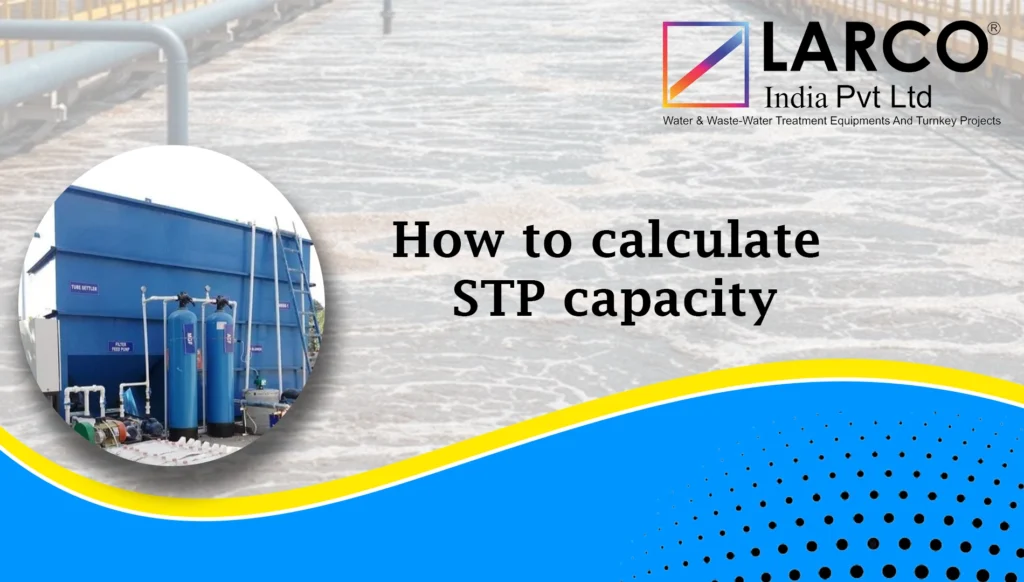Sewage Treatment Plants (STPs) are essential for treating and preparing wastewater for discharge back into the environment in the context of wastewater management. Understanding how to calculate STP capacity is crucial for communities and industry alike to guarantee effective wastewater treatment and adherence to environmental rules. This article will go through how to calculate STP capacity in great depth. It is given to you by Larco India Pvt. Ltd., a recognized expert in sustainable environmental solutions.
Step 1: Defining How to Calculate STP Capacity
how to calculate STP capacity is the greatest amount of wastewater that a treatment plant can efficiently manage in a specific amount of time. It’s a key factor in the design and engineering of STPs to handle the wastewater produced by a particular facility or population.
Step 2: Gathering Essential Information
Before beginning to determine STP capacity, one must collect important information, such as:
The average amount of wastewater produced each day is called the average daily flow (ADF).
Retention Time (RT): The intended amount of time for wastewater to be kept in the treatment plant for efficient processing. Peak Flow Factor (PFF): A factor accounting for peak flow periods or surges in wastewater.
Step 3: Calculating Peak Flow
Peak Flow (PF) is the greatest anticipated flow of wastewater at any particular time and is determined by the following formula:
PF=ADF×PFF.
Step 4: Determining Total Daily Flow
Average Daily Flow (ADF) and Peak Flow (PF) are added together to create the Total Daily Flow (TDF):
TDF=ADF+PF.
Step 5: Calculating Required Tank Volume
Utilising the Total Daily Flow (TDF) and Retention Time (RT), calculate the necessary tank volume (V):
V=TDF×RT
Step 6: Adjustments for Sludge and Aeration
Consider the STP’s sludge settling and aeration systems’ space requirements. To determine the ultimate tank volume necessary for efficient treatment, take these elements into account.
Step 7: Finalizing the STP Design
The computed tank volume and any other adjustments must be added to finish the Sewage Treatment Plant design. This provides a key service for a cleaner and greener environment and ensures that the STP can handle wastewater correctly.
Advantages of stp capacity calculating
Efficient Resource Allocation:
- One of the most important steps in developing a successful wastewater treatment system is calculating the capacity of the sewage treatment plant (STP). The volume of wastewater that a STP can process over a certain length of time is what determines its capacity. Here is a step-by-step explanation of how to calculate STP capacity:
Cost-Effectiveness:
- Planning and design that are cost-effective benefit from accurately how to calculate STP capacity. Both the initial investment and ongoing operating costs can be reduced by avoiding unneeded costs associated with large structures or updating subpar systems.
Environmental Compliance:
- Ensuring compliance with environmental rules and standards requires understanding and determining STP capacity. To prevent fines and penalties for exceeding permissible discharge levels, it’s critical to comply with regulatory regulations.
Optimized Treatment Process:
- By estimating the appropriate flow rates and retention times, STP capacity estimates help to optimize the treatment process. This guarantees that the wastewater gets through the required treatment steps for efficient contaminant removal.
Improved Performance and Reliability:
- The treatment plant functions within its design parameters with increased performance and dependability if the STP capacity is enough. Systems that are appropriately sized have a higher chance of regularly delivering on performance goals.
Conclusion
The design and implementation of efficient wastewater treatment systems depends on having a solid understanding of how to calculate STP capacity. Industries and communities may guarantee that their STPs are constructed to optimally manage wastewater by following the detailed instructions provided by Larco India Pvt. Ltd., helping to secure a sustainable and ecologically responsible future.

